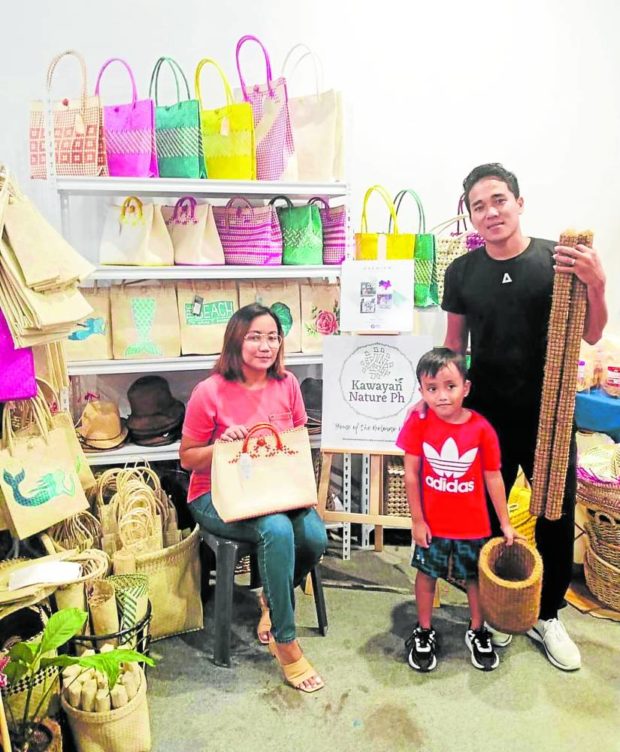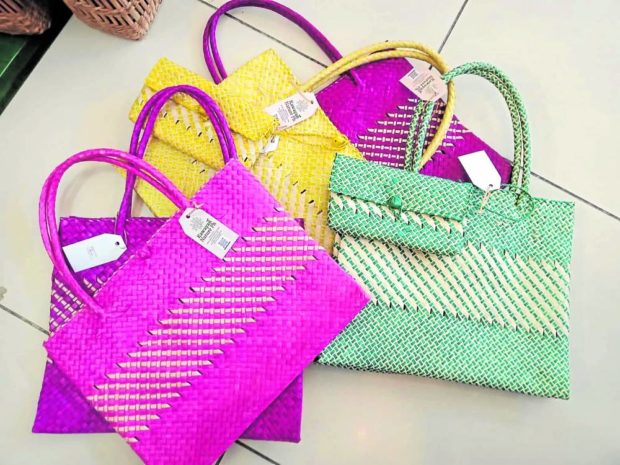From Bolinao to Maldives: Buri bags, mats go global

ECO-FRIENDLY | Precious Cayaon, the founder of Kawayan Nature PH, shows some of the buri bag designs that are available for local and international markets. (Photo by YOLANDA SOTEL / Inquirer Northern Luzon)
BOLINAO, Pangasinan, Philippines — Every day, Betty Carolino, 54, would weave buri strips into different shapes of bags, planters, and mats. Her husband would assist her by stripping the buri and dyeing them with bright colors, while their two sons would help her with the actual weaving.
Carolino is one of the 20 women in the seven villages on Santiago Island who are basket or mat weavers for local markets. The island is part of this coastal Pangasinan town that juts into the West Philippine Sea.
The island is where buri (Corypha elata Roxb) or common palm trees grow, and villagers would strip, color, and weave their leaves into different products.
For years, the women of the island have been weaving bags and mats to augment their income from farming or fishing, their main sources of livelihood.
But this industry, which has been helping them put food on the table, has started to penetrate the international market, increasing the demand that they can hardly meet.
Article continues after this advertisement
Precious Cayaon her husband Jeffry and son Jeious Thaddeus Olly with some of the products of Kawayan Nature Ph. (Photo courtesy of Kawayan Nature Ph )
Breakthrough
It was a local resident who was working in the Maldives as a travel consultant who introduced the buri bags to resort owners in that country that boasts a high-end tourism industry.
Article continues after this advertisement“I was supplying buri bags to different resorts in Maldives and have established the business I named Kawayan Nature Ph,” Precious Cayaon, 32, told the Inquirer in an interview on July 15.
She added: “Maldives promotes sustainable and eco-friendly products in the tourism industry, so I decided to introduce the buri products to the resort owners.”
The bags come in different designs and sizes according to their use — as a coin purse, a wine bottle holder, a gift box, a beach or office bag — and are hand-painted with exclusive designs by young artists from the town.
Sleeping mats (banig) have also been marketed in Maldives as “beach mats,” becoming best-sellers there, Cayaon said.
Aside from Maldives, Kawayan Nature Ph is also exporting to Dubai, and has been contacted by a Filipino who owns a winery in Switzerland to supply her with wine bags.

LIVELIHOOD | Betty Carolino, 54, is among the residents of Santiago Island who weave bags out of buri leaves which are abundant in their community. Weaving gives island villagers a chance to earn extra and express their creativity. (Photo courtesy of Kawayan Nature PH)
Women weavers
It was Cayaon’s husband who tapped a group of women to weave the bags according to her specifications, which she thought would click with high-end clients and tourists.
The volume of sales was picking up, but then the COVID-19 pandemic broke out in early 2020. Cayaon said there were no flights at that time, so she could not import the buri products from the Philippines.
Maldives also stopped its tourism-related operations, although some resorts continued to sell the buri products, she said.
Cayaon eventually managed to go back to the Philippines, but she could still not ship the buri bags to Maldives due to quarantine restrictions, which made weavers lose their source of income.
But, when the garden and ornamental plant industry bloomed during the pandemic, it soon benefited the weavers who ventured into a new business opportunity that catered to the needs of “plantitos” and “plantitas” (plant enthusiasts).
“The Bolinao government asked me to help the weavers, and we came up with ‘planters’ or containers for flower or plant pots, which turned out to be a popular product. So even during the pandemic, the weavers were able to earn,” Cayaon said.
Even when restrictions on international flights started to ease, Cayaon did not return to Maldives, preferring to continue working as a travel consultant online so she could supervise the fledgling business.

PROUDLY PINOY Philippine-made buri bags in vibrant colors are a hit among tourists in Maldives. (Photo by YOLANDA SOTELO / Inquirer Northern Luzon)
Digital marketing
She admits that digital marketing is a big help to the industry, disclosing that while the island residents have been weaving all their lives, their market was limited.
But through social media, the products were advertised, and she was able to get orders from far and wide.
She said it was also through social media that some “devious” people tried to copy the designs, and even went directly to ask the weavers and the painters to work for them.
“Thankfully, the weavers refused to work for them. Even the painters declined to paint for other businessmen, saying the designs were exclusive for Kawayan Nature Ph,” Cayaon said.
She said the buri products were named after the Santiago Island’s villages of Salud, Pilar, and Victory as a sort of tribute to the weavers.
However, due to the high demand for environmentally friendly products, the industry is facing some challenges, such as the loss of materials such as buri and a lack of interest in weaving among younger people.
“Buri leaves have many uses, and other towns source the materials for their handicrafts and even for ‘patopat’ (a native delicacy) from Santiago Island. There could be a time when no raw materials would be left for the local industry, so we hope there could be a move to make buri leaves on the island exclusive for the local weavers,” Cayaon said.
She added: “Another challenge is that the weavers are aging and we are hoping to create interest among the young people for weaving by showing them that they can earn money from the industry.”
After all, buri leaves can be versatile and the products that can be weaved out of them are limited only by one’s imagination, Cayaon said.
RELATED STORIES
Seamless transition of Cordillera weaving
Weaving house helps preserve Yakan culture